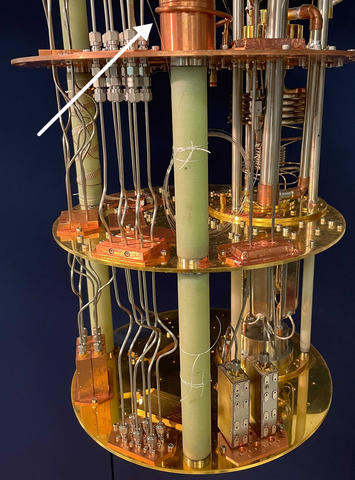2021/3/24 アメリカ合衆国・国立標準技術研究所(NIST)

・ NIST が、従来の金属配線の代わりに光ファイバーを利用した、超伝導量子ビット(q ビット)の読み出し・制御システムを開発。数百万 q ビットの量子コンピューター実現に向けた進展が期待される。
・ 超伝導回路は、大量生産が容易なことや安定性の高さから量子コンピューター開発における先導的技術とされるが、極低温での作動が必要なため室温の電子機器への配線の複雑化や q ビットの過熱が課題。あらゆる問題の解決が可能なユニバーサル量子コンピューターでは約百万 q ビットが必要となるが、金属配線による従来の希釈冷凍機で扱えるのは最大でも僅か数千 q ビットに留まる。
・ 情報通信ネットワーを支える光ファイバーでは、ガラスやプラスチックのコアが熱伝導無く高容量の光信号を伝送する。超伝導量子コンピューターでは情報の記憶・処理にマイクロ波を利用するため、光をマイクロ波に正確に変換することが重要となる。
・ 光ファイバーと標準的なコンポーネントを組み合わせた新システムは、単一粒子のフォトンのレベルで光を変換、伝送、測定し、マイクロ波への容易な変換を可能にするもの。金属配線と同様の効果を提供し、壊れやすい q ビットの量子状態を維持する。
・ 通常では、室温下生成のマイクロ波パルスは同軸ケーブルを通じて極低温の超伝導 q ビットに供給されるが、新システムのフォトニックリンクでは、光ファイバーを通じて極低温光検出器に伝送した光信号をマイクロ波に変換し、超伝導 q ビットに供給される。
・ 同フォトニックリンクで生成したマイクロ波パルスによる q ビットの量子状態の測定と制御の実験を実施。実験で使用した「トランズモン」q ビットは、3D キャビティに埋め込まれたジョセフソン接合で、絶縁体で隔てた 2 種類の超伝導電極から構成される。
・ マイクロ波を電気光学変調器でより高い光周波数に変換して q ビットの量子状態を制御。これらの光信号は室温から 4 ケルビン(-269℃)を経て光ファイバーを移動し、さらに 20 ミリケルビンで極低温光検出器に到達。光信号はそこでマイクロ波に再び変換され、量子回路に伝送された。
・ また、q ビットの量子状態の測定では、変調器、光ファイバー、光検出器を通じて特定のエネルギーレベルで赤外線を放射し、キャビティの共振周波数を測定。レーザー出力を抑えた q ビットの振動を起点に、フォトニックリンクで微弱なマイクロ波パルスをキャビティに伝送。キャビティの周波数は、従来の同軸ケーブルによるものと同等の 98%の確率で q ビットの状態を正確に提示した。
URL: https://www.nist.gov/news-events/news/2021/03/optical-fiber-could-boost-power-superconducting-quantum-computers
<NEDO海外技術情報より>
(関連情報)
Nature 掲載論文(アブストラクトのみ:全文は有料)
Control and readout of a superconducting qubit using a photonic link
URL: https://www.nature.com/articles/s41586-021-03268-x
Abstract
Delivering on the revolutionary promise of a universal quantum computer will require processors with millions of quantum bits (qubits)1,2,3. In superconducting quantum processors4, each qubit is individually addressed with microwave signal lines that connect room-temperature electronics to the cryogenic environment of the quantum circuit. The complexity and heat load associated with the multiple coaxial lines per qubit limits the maximum possible size of a processor to a few thousand qubits5. Here we introduce a photonic link using an optical fibre to guide modulated laser light from room temperature to a cryogenic photodetector6, capable of delivering shot-noise-limited microwave signals directly at millikelvin temperatures. By demonstrating high-fidelity control and readout of a superconducting qubit, we show that this photonic link can meet the stringent requirements of superconducting quantum information processing7. Leveraging the low thermal conductivity and large intrinsic bandwidth of optical fibre enables the efficient and massively multiplexed delivery of coherent microwave control pulses, providing a path towards a million-qubit universal quantum computer.



